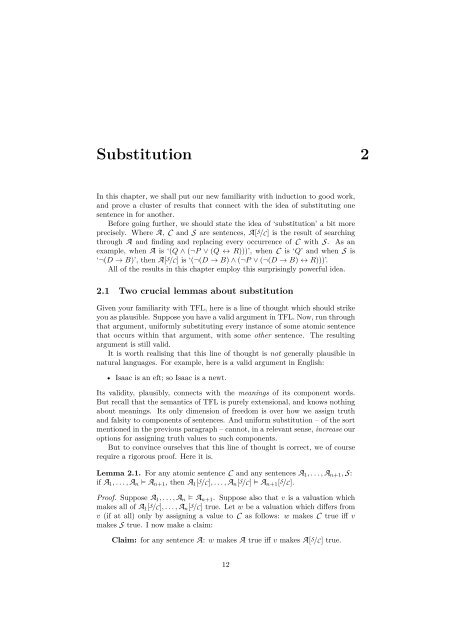Metatheory - University of Cambridge
Metatheory - University of Cambridge
Metatheory - University of Cambridge
Create successful ePaper yourself
Turn your PDF publications into a flip-book with our unique Google optimized e-Paper software.
Substitution 2<br />
In this chapter, we shall put our new familiarity with induction to good work,<br />
and prove a cluster <strong>of</strong> results that connect with the idea <strong>of</strong> substituting one<br />
sentence in for another.<br />
Before going further, we should state the idea <strong>of</strong> ‘substitution’ a bit more<br />
precisely. Where A, C and S are sentences, A[S/C] is the result <strong>of</strong> searching<br />
through A and finding and replacing every occurrence <strong>of</strong> C with S. As an<br />
example, when A is ‘(Q ∧ (¬P ∨ (Q ↔ R)))’, when C is ‘Q’ and when S is<br />
‘¬(D → B)’, then A[S/C] is ‘(¬(D → B) ∧ (¬P ∨ (¬(D → B) ↔ R)))’.<br />
All <strong>of</strong> the results in this chapter employ this surprisingly powerful idea.<br />
2.1 Two crucial lemmas about substitution<br />
Given your familiarity with TFL, here is a line <strong>of</strong> thought which should strike<br />
you as plausible. Suppose you have a valid argument in TFL. Now, run through<br />
that argument, uniformly substituting every instance <strong>of</strong> some atomic sentence<br />
that occurs within that argument, with some other sentence. The resulting<br />
argument is still valid.<br />
It is worth realising that this line <strong>of</strong> thought is not generally plausible in<br />
natural languages. For example, here is a valid argument in English:<br />
• Isaac is an eft; so Isaac is a newt.<br />
Its validity, plausibly, connects with the meanings <strong>of</strong> its component words.<br />
But recall that the semantics <strong>of</strong> TFL is purely extensional, and knows nothing<br />
about meanings. Its only dimension <strong>of</strong> freedom is over how we assign truth<br />
and falsity to components <strong>of</strong> sentences. And uniform substitution – <strong>of</strong> the sort<br />
mentioned in the previous paragraph – cannot, in a relevant sense, increase our<br />
options for assigning truth values to such components.<br />
But to convince ourselves that this line <strong>of</strong> thought is correct, we <strong>of</strong> course<br />
require a rigorous pro<strong>of</strong>. Here it is.<br />
Lemma 2.1. For any atomic sentence C and any sentences A 1 , . . . , A n+1 , S:<br />
if A 1 , . . . , A n ⊨ A n+1 , then A 1 [S/C], . . . , A n [S/C] ⊨ A n+1 [S/C].<br />
Pro<strong>of</strong>. Suppose A 1 , . . . , A n ⊨ A n+1 . Suppose also that v is a valuation which<br />
makes all <strong>of</strong> A 1 [S/C], . . . , A n [S/C] true. Let w be a valuation which differs from<br />
v (if at all) only by assigning a value to C as follows: w makes C true iff v<br />
makes S true. I now make a claim:<br />
Claim: for any sentence A: w makes A true iff v makes A[S/C] true.<br />
12
















